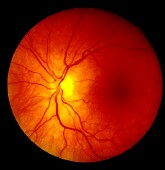Faster decision making when viewing fundus photograph compared with slit lamp simulation
FRIDAY, May 8, 2015 (HealthDay News) — Experienced eye care clinicians use holistic image information, which is present in fundus photographs but not when using the restricted view of slit lamps, according to a study published online May 1 in Ophthalmic & Physiological Optics.
Matthew J. Stainer, Ph.D., from the University of Dundee in the United Kingdom, and colleagues examined how expert and novice clinicians inspect the fundus using photographs and viewing the eye in vivo using the restricted view of a slit lamp. Ten experienced and 10 novice clinicians examined 64 photographs of human retinae. Half the images were viewed as fundus photographs while clinicians’ eye positions were recorded. The other half were viewed via a simple slit lamp simulation where a computer mouse was used to control the position of a viewing window, revealing an underlying photograph.
The researchers found that experienced clinicians made decisions significantly faster than novices, with the photograph viewing linked to faster decision making versus the slit lamp simulation. Novices spent longer examining the optic nerve head than other regions, although the distribution of inspection was similar. Significantly earlier inspection of the optic nerve head was noted for experienced clinicians when it was considered to be unhealthy.
“Holistic processing benefits were only present in experts’ free-viewing fundus photographs; the limited field of view from the slit lamp disrupts such global image benefits,” the authors write.
Copyright © 2015 HealthDay. All rights reserved.








